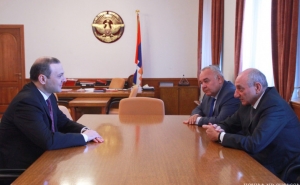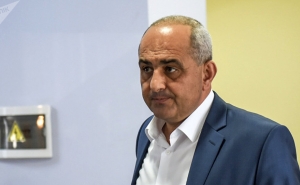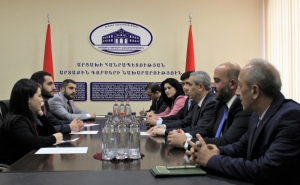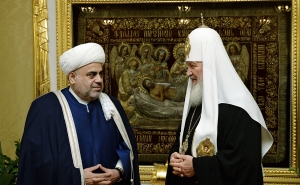 From Avarayr to Ottoman Invaders: Struggle of Artsakh People for the Right of Peaceful Existence in Their Homeland
From Avarayr to Ottoman Invaders: Struggle of Artsakh People for the Right of Peaceful Existence in Their Homeland

The Armenians, one of the ancient nations in the world, throughout the years of their existence were and continue struggling for their right of peaceful existence in their historical homeland. The fact that in the 21st century Armenians managed not only to survive but have two independent republics, the Republic of Armenia and the Republic of Artsakh (otherwise known as Nagorno-Karabakh Republic) is a vivid proof of the success of the centuries long struggle that the Armenians were forced to fight to preserve their religion, culture and language.
Notwithstanding the victory and the existing achievements, Armenians are still in a continuous struggle for their independence. The Armenians in the Artsakh Republic continue to surprise the world by their strong will and irresistible courage that helps them not only to keep their border unconquerable but to continue to flourish as a nation and a state developing their culture, religion, language and democratic political institutions.
One will ask how the Artsakh Armenians manage to be in a continuous struggle for more than two decades and still not become exhausted. The answer is clear: the fight of the Artsakh people is not limited to these twenty years: Armenians in Artsakh have been in the continuous long struggle since the very establishment of the first Armenian kingdom. So what is the path of that struggle the Armenians in Artsakh Republic managed to overcome to reach to our days?
The authors like Strabo (64/63 BC – ca. AD 24), Pliny the Elder (23 AD – August 25, 79 AD), Claudius Ptolemy (c. AD 90 – c. AD 168), Plutarch (c. 46 – 120 AD), Dion Cassius (c. AD 150 – 235) and others in their works named the natural borders of Armenia passing through the Kur River, which means that present Artsakh Republic was within the borders of Armenia. During the era of Urartu, Artsakh was known as Urtekhe-Urtekhini. Later, in the middle of the first century B.C the Armenian King Tigran the Great, recognizing the strategic importance of Artsakh, built one of the four cities that bore his name Tigranakert there, which became one of the main cultural and political centers in the Mets Hayq during the reign of Tigran the Great.
Later, after Armenia was divided into two parts, between Byzantine Empire and Persia (387 A.D.), Eastern Armenia, including Artsakh Republic, fell under the rule of the Persian Empire. It is worth mentioning that even under the foreign rule the Armenians in Artsakh strived to preserve their identity, culture and religion. The proof that Artsakh Republic became one of the main cradles for preservation of the Armenian religion, culture and identity, is the fact that the very first school, where the Armenian new alphabet was used for teaching by its creator, St. Mesrob Mashtots, was in the Amaras Monastery in Artsakh Republic, founded in the 5th century. 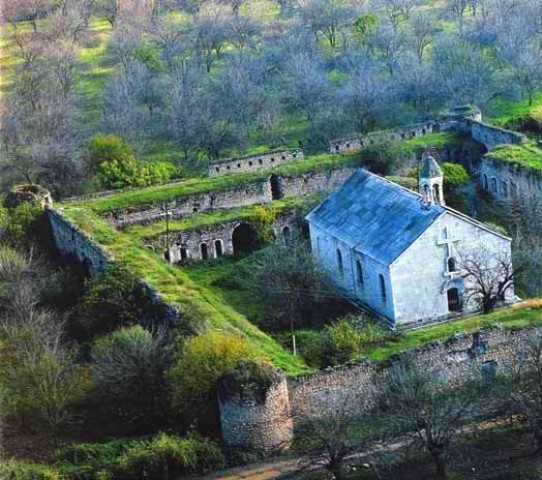
To remain stronger and united even under the foreign rule, Artsakh and neighboring Utik (a historic province of the Kingdom of Armenia) were united under the rule of the Armenian dynasty Aranshahiks. Vache Second from the Aranshahiks dynasty participated in the battle of Avarayr (451) fought by Armenian Army under Vardan Mamikonyan against Sassanid Persia . In the battle forces of Vache Second had determinant role in the victory of the Armenians (the victory was strategic for the Armenians as it resulted in signing the Nvarsak Treaty (484 AD) which gave right to preach Christianity in Armenia freely). Later to reestablish the order in his kingdom, Vachagan Barepasht (487-510), brother of Vache the Second (although some writers consider him to be from the Arshakuni dynasty), adopted one of the oldest constitution in the world, which is said to lay the bases of the future Armenian states.
However, the Artsakh people were still to fight for their right of peaceful existence. After the Seljuk Turks defeated the Byzantines at the battle of Manzikert in 1071, the Armenians in Eastern Armenia were forced to fight hard to defeat their autonomy. The two mountainous kingdoms of Syunik and Lori as well as principality of Khachen (Armenian principality in lower Karabakh, Nagorno-Karabakh and Zangezur) due to their strong resistance managed to preserve their autonomy. In the principality of Khachen Armenian princely family of Hasan Jalalyan was ruling. During their rule the principality of Khachen became prosperous with a number of churches, castles and military installations being constructed such as Hovhannes Mkrtich Church and narthex at Gandzasar (1216-1260), Dadivank’s Cathedral Church (1214), and the Gtchavank Monastery (1241-1248). Gandzasar Monetary became the patriarch throne of the north-eastern provinces of Armenia.
After the death of Hasan Jalalyan Artsakh Armenians were forced to struggle against Tatar-Mongols, who turned many Christian Monuments and Churches into ruins. It is reported that those tribes started to call Artsakh "Karabakh", which comes from the Turkic word "black" (kara) and Persian word for "garden" (bakh). However, this time also Armenians in Artsakh managed to survive and in the 16 century formed administrative-political units called Melikutyun (Melikdoms). Five Armenian Melikdoms - Dizak, Gulistan, Jraberd, Khachen and Varanda were formed, otherwise called "Khamsa Melikdoms" (Khamsa means five in Arabic), which became known as Karabakh khanate under the Persian rule. From 16 to 18 century these very melikdoms managed to struggle against the Ottoman forces and prevented their invasion into their land.
In 1813, the Treaty of Gulistan was signed between Persia and Russia and Persia conceded to Russia almost all of Eastern Transcaucasia’s khanates, including the Karabakh khanate. After the collapse of the Russian empire the struggle of Artsakh people continued this time against Caucasian Tatars (known today as Azerbaijanis), descendants of Turkic speaking nomadic tribes, who had gradually infiltrated into Karabakh. In 1920, Turkish and Azerbaijan forces invaded Artsakh making the Armenians in Arstakh to again embark on the struggle for their right of peaceful existence in their own homeland…
Other materials on this subject
- Russian forces have clearly failed in their duties: senators press Biden Administration to break Azerbaijan’s blockade The United States cannot stand aside while the Aliyev regime callously threatens the lives of Nagorno-Karabakh’s citizens, and must hold Azerbaijan to account for blocking a civilian population’s access...
- US calls for the full restoration of free movement through the Lachin Corridor "We remain concerned about impeded access to the Lachin Corridor and the humanitarian implications of this situation. This sets back the peace process and undermines international confidence. We call for...
- Azerbaijani forces violate the ceasefire in Artsakh The ceasefire violation was reported to the command of the Russian peacekeeping troops.
- Azerbaijani units violate ceasefire in several directions, Artsakh’s Defense Ministry says The Armenian side has no losses. The incidents of ceasefire violations were reported to the command of the Russian peacekeeping troops.
- Russian Diplomat Reassures Armenians Over Corridor In Karabakh "The parties are in direct contact, and I assure you that the peacekeepers will not move a single centimeter until there is a new corridor," Seleznyov said.
-
 17:08
17:08The regular session of the Anti-corruption Policy Council takes place in Jermuk
-
 15:05
15:05The Prime Minister sends congratulatory messages to the supreme leader of Iran and the President of Iran
-
 11:11
11:11Armenia sends earthquake aid to Turkey
-
 10:43
10:43Commemoration of the Pontiff St. Sahak Partev
-
 09:16
09:16Some roads are closed and difficult to pass in Armenia
-
 19:55
19:55Phone conversation of the Foreign Minister of Armenia with the U.S. Assistant Secretary of State for European and Eurasian Affairs
-
 18:30
18:30Prime Minister Pashinyan and President Khachaturyan meet
-
 18:20
18:20Ararat Mirzoyan with Co-Chairman of the OSCE Minsk Group of France Brice Roquefeuil
-
 17:01
17:01Humans could land on Mars within 10 years, Musk predicts
-
 16:45
16:45France, US urge 'immediate' end to Nagorno Karabakh blockade
-
 16:01
16:01Blockaded Nagorno Karabakh launches fundraiser to support quake-hit Syria
-
 15:59
15:59Earthquake death toll in Turkey rises to 18,342
-
 15:43
15:43Ararat Mirzoyan Held a Telephone Conversation with Sergey Lavrov
-
 15:06
15:06French president rules out fighter jet supplies to Ukraine in near future
-
 14:47
14:475 Day Weather Forecast in Armenia
-
 14:44
14:44President Vahagn Khachaturyan wrote a note in the book of condolences opened in the Embassy of Syria in Armenia
-
 14:20
14:20Azerbaijan’s provocations impede establishment of peace and stability – Armenian FM tells Russian Co-Chair of OSCE MG
-
 12:57
12:57France representation to OSCE: Paris calls on Azerbaijan to restore freedom of movement through Lachin corridor
-
 11:40
11:40Command of Kosovo forces highly appreciated preparation of Armenian peacekeepers
-
 10:16
10:16The United States withdrew from sanctions against Syria for six months the provision of assistance after the earthquake
day
week
month
Humidity: %
Wind: km/h



